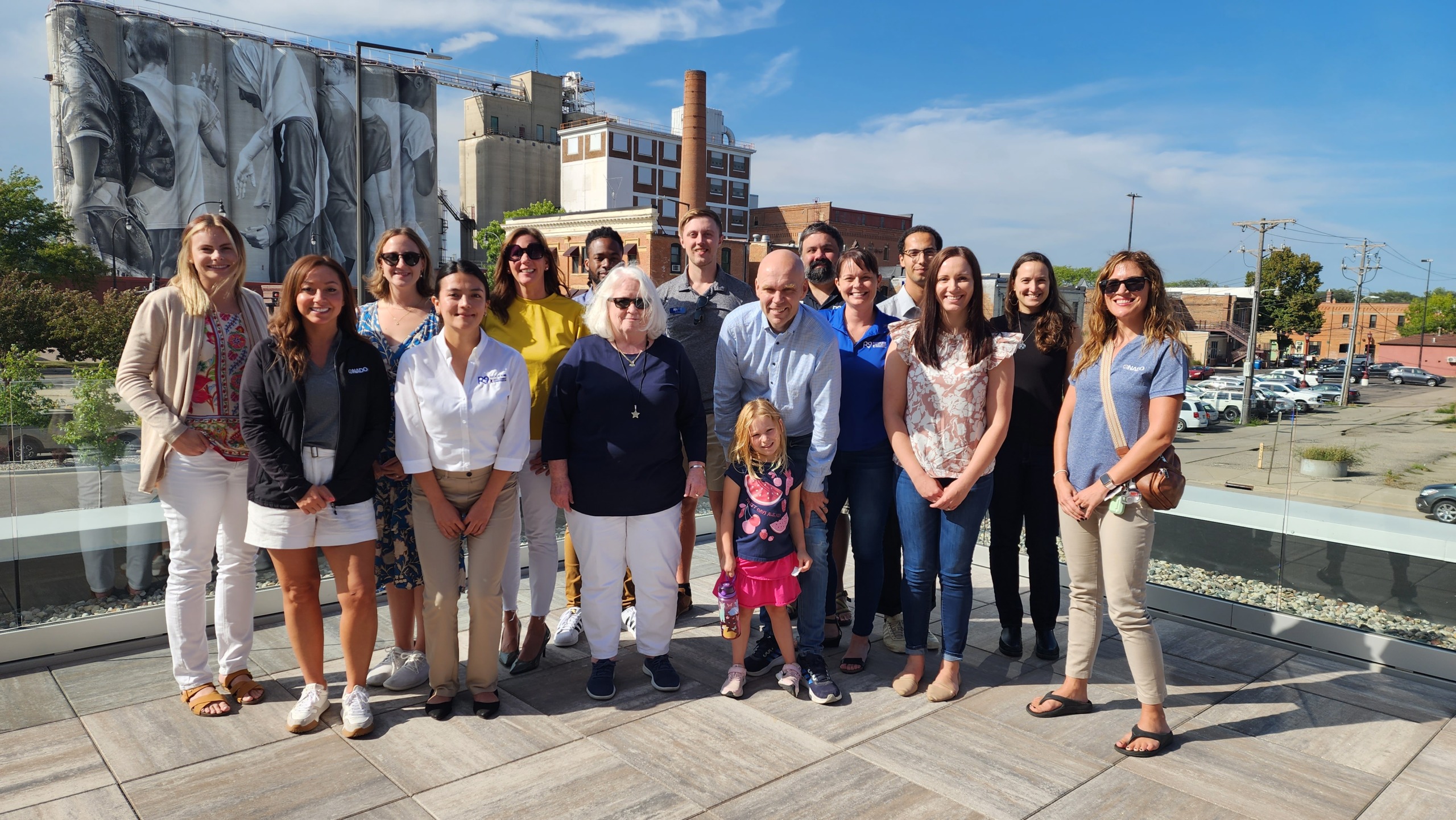Economic development work doesn’t happen overnight and Waseca Economic Development Coordinator Gary Sandholm does a lot of work behind the scenes with a variety of organizations.
Some of that work means contact with the Department of Employment and Economic Development to see what businesses might be looking for a spot that will fit in Waseca. Other times it means working with organizations like the Community Venture Network where companies can pitch to communities. Waseca shares a partnership with Fairmont and Mountain Lake in the Community Venture Network, which extends into eight states. Sometimes businesses can be attracted through word of mouth.
Sandholm can help businesses already in the area and with startups navigate through the process.
“If a business is looking to expand, there is where we can use DEED,” Sandholm said.
Organizations like the Region Nine Development Commission and Southern Minnesota Initiative Foundation have funding available for entrepreneurs. The Waseca EDA can also provide loans for businesses.
Then there is the Small Business Development Center in Mankato where entrepreneurs can get advice and learn how to write business plans. SCORE is another group that will provide mentoring for those seeking to start a business.
Since joining the city of Waseca four years ago, Sandholm has worked to fill the void left after the Quad Graphics closing left nearly 400 people out of work. The city received around a $600,000 grant from the U.S. Economic Development Authority that will go toward finding a person to reach out to businesses.
“The purpose that this person will try to fill is the outreach to industries and businesses on a wider scale than what we’re able to do for one person,” Sandholm said. “More outward than local businesses.”
Part of that grant money is being used to do a viability study of an area manufacturing resource center, which Region Nine will do.
Some businesses have started to fill the building Quad Graphics occupied. Midwest Hemp Farms, Rhino Markers and Green Forest Recycling have moved into the building.
“One of the things we’ve been fortunate about is that the job demand in this region has been very strong,” Sandholm said. “So the people laid off by Quad and Clear Lake Press, have basically been rapidly absorbed into the workforce.”
But the closure has meant fewer workers coming into Waseca.
“Three, four years ago we had a net surplus of people driving into Waseca to work,” Sandholm said. “Far more than drove out. Now that’s flip flopped. We haven’t seen people moving away from Waseca. People are working in Mankato, Owatonna, Austin, Albert Lea. That hurts the local economy because they’re probably not spending as much money locally.”
Sandholm dealt with an Electrolux plant closing in his hometown of Dayton, Iowa where he worked as an economic development coordinator. He worked as the economic development coordinator and Chamber of Commerce director in Hartford, South Dakota before joining the city of Waseca.
He sees the education system in Waseca and the transportation access as selling points to business. Plus, the railway has capacity and there’s utility capacity available. Waseca also has building space available.
“We have a building space surplus,” he said. “We’ve got a lot more building space than we’d like to have right now.”
View the Waseca County News article.
 RNDC Celebrates 3rd Annual Local Foods WeekJuly 23, 2024 - 11:09 am
RNDC Celebrates 3rd Annual Local Foods WeekJuly 23, 2024 - 11:09 am RNDC Shares Strategic Economic Development Plan Results at Faribault County MeetingMay 12, 2024 - 11:34 am
RNDC Shares Strategic Economic Development Plan Results at Faribault County MeetingMay 12, 2024 - 11:34 am Region Nine Issued the Nation’s First A Rating for Corn StoverApril 19, 2024 - 12:56 pm
Region Nine Issued the Nation’s First A Rating for Corn StoverApril 19, 2024 - 12:56 pm

Shining Bright: Solar Power Continues Growth
in News/by Region NineJoel Hanif, community development planner for the Region Nine Development Commission, hopes to help spur even more interest in solar by getting the region qualified as a SolSmart designated region.
“There’s no guaranteed funding that comes with it, but it might make Region Nine competitive for other solar programs if there are grants down the line if we show we did the legwork.”
Hanif said the SolSmart designation also creates more public awareness and education about the benefits of solar power.
View the full Minnesota Valley Business June 2020 article.
Region 9 Issues Statement on George Floyd
in News/by Region NineThe killing of George Floyd on Tuesday and ensuing unrest have ripped open the festering wound of racism that pervades our state and nation. This atrocity reminds us of both the deep inequities in our society and the privileged status many of us hold.
I write today because my heart aches for Mr. Floyd, his family, friends, and colleagues. My heart aches for the soul of Minneapolis and the State of Minnesota. My heart aches for the millions of Black Minnesotans and Americans who so often live in fear and suspicion of the very institutions that are supposed to serve and protect them.
But this isn’t about me. This is about George Floyd and the millions of people who are denied the same rights and freedoms I enjoy. I write today because what happened to Mr. Floyd was not only horrifying and unjust, it was preventable.
He died because those police officers placed less value on his life as a black man than they would on mine as a white woman. Mr. Floyd’s death was preventable because our communities could have and should have been conducting the work necessary to dismantle institutional racism and challenge our own biases.
While we have a long way to go, Region Nine Development Commission has taken steps to address some of these issues through a program called Welcoming Communities, which aims to both restore economic justice by facilitating minority entrepreneurship and improve quality of life by encouraging communities to engage positively with residents of color.
We started this work several years ago, treating it as an economic development issue, just like the need for roads, bridges, and childcare providers. Over time, Welcoming Communities has evolved into a forum to confront biases and learn to cherish the contributions and humanity of all Minnesotans.
This week, we have yet again been reminded why we and our partners must work harder than ever. We must search ourselves, our families, and our communities with the renewed conviction that oppression is the status quo and we are the agents responsible for change.
Ultimately, the goal of this work is to sew justice, dignity, and love. We must support our neighbors now more than ever. The Welcoming Communities’ work is no longer just a regional economic development need. It is, as this week’s events remind us, a moral imperative.
-KTOE article.
May 2020 E-Newsletter
in Newsletter/by Region NineRead Now.
BCBS of Minnesota Awards $20,000 for COVID-19 Response
in News/by Region NineThe Blue Cross and Blue Shield (BCBS) Foundation of Minnesota has awarded $20,000 in response to COVID-19. An additional $2,500 is being donated by SJP Consulting, to make a total of $22,500. The funds will be given to local food shelves in the communities where the Rural Equity Learning Community (RELC) and Welcoming Communities Project (WCP) programs have been held. Funds have already been distributed to Saint Peter Area Food Shelf, Springfield Food Shelf, Watonwan County Food Shelf, and the Salvation Army for Martin County and Montgomery.
April 2020 E-Newsletter
in Newsletter/by Region NineRead Now.
Region Nine In a Unique Position To Help in a Unique Time
in News/by Region NineRegion Nine Development Commission says they’re in a unique position to help businesses and local governments deal with the unique situation of the COVID-19 pandemic. Nicole Grienswic-Mickelson is the executive director of Region Nine.
“We’re trying to help determine where the void is in technical assistance and how we can help fill that gap,” said Grienswic-Mickelson. “A lot of our other partners are doing similar things. We’re just trying to be the best partner we can to DEED and other folks.”
Grienswic-Mickelson says their office is closed, but their staff is available by phone, e-mail or other forms of electronic communication.
View the KTOE article.
PORTRAITS: Economic development work forged on a reliance of networks
in News/by Region NineEconomic development work doesn’t happen overnight and Waseca Economic Development Coordinator Gary Sandholm does a lot of work behind the scenes with a variety of organizations.
Some of that work means contact with the Department of Employment and Economic Development to see what businesses might be looking for a spot that will fit in Waseca. Other times it means working with organizations like the Community Venture Network where companies can pitch to communities. Waseca shares a partnership with Fairmont and Mountain Lake in the Community Venture Network, which extends into eight states. Sometimes businesses can be attracted through word of mouth.
Sandholm can help businesses already in the area and with startups navigate through the process.
“If a business is looking to expand, there is where we can use DEED,” Sandholm said.
Organizations like the Region Nine Development Commission and Southern Minnesota Initiative Foundation have funding available for entrepreneurs. The Waseca EDA can also provide loans for businesses.
Then there is the Small Business Development Center in Mankato where entrepreneurs can get advice and learn how to write business plans. SCORE is another group that will provide mentoring for those seeking to start a business.
Since joining the city of Waseca four years ago, Sandholm has worked to fill the void left after the Quad Graphics closing left nearly 400 people out of work. The city received around a $600,000 grant from the U.S. Economic Development Authority that will go toward finding a person to reach out to businesses.
“The purpose that this person will try to fill is the outreach to industries and businesses on a wider scale than what we’re able to do for one person,” Sandholm said. “More outward than local businesses.”
Part of that grant money is being used to do a viability study of an area manufacturing resource center, which Region Nine will do.
Some businesses have started to fill the building Quad Graphics occupied. Midwest Hemp Farms, Rhino Markers and Green Forest Recycling have moved into the building.
“One of the things we’ve been fortunate about is that the job demand in this region has been very strong,” Sandholm said. “So the people laid off by Quad and Clear Lake Press, have basically been rapidly absorbed into the workforce.”
But the closure has meant fewer workers coming into Waseca.
“Three, four years ago we had a net surplus of people driving into Waseca to work,” Sandholm said. “Far more than drove out. Now that’s flip flopped. We haven’t seen people moving away from Waseca. People are working in Mankato, Owatonna, Austin, Albert Lea. That hurts the local economy because they’re probably not spending as much money locally.”
Sandholm dealt with an Electrolux plant closing in his hometown of Dayton, Iowa where he worked as an economic development coordinator. He worked as the economic development coordinator and Chamber of Commerce director in Hartford, South Dakota before joining the city of Waseca.
He sees the education system in Waseca and the transportation access as selling points to business. Plus, the railway has capacity and there’s utility capacity available. Waseca also has building space available.
“We have a building space surplus,” he said. “We’ve got a lot more building space than we’d like to have right now.”
View the Waseca County News article.
March 2020 E-Newsletter
in Newsletter/by Region NineRead Now
KTOE: Al in the Afternoon Interview with Nicole Griensewic Mickelson
in News/by Region NineListen to the KTOE podcast (starting at 1:12) in response to COVID-19.
Region Nine Responds to COVID-19
in News/by Region NineKey facts to know about COVID-19 can be found here. For more information on what you can do to prevent the spread of COVID-19 visit the CDC website.